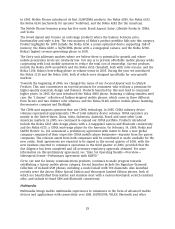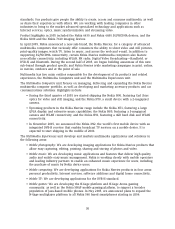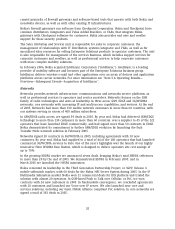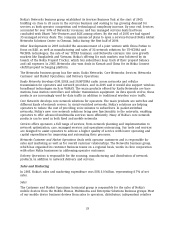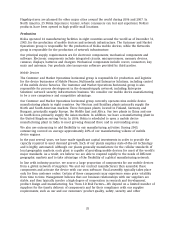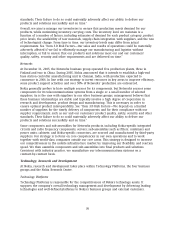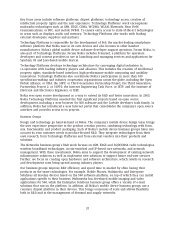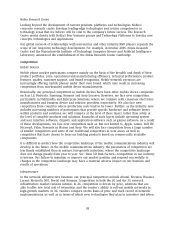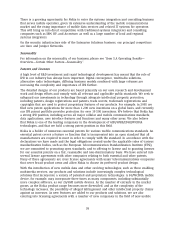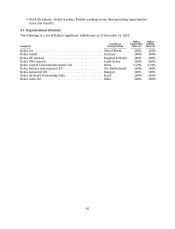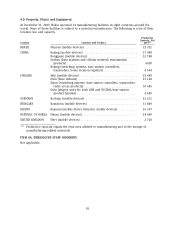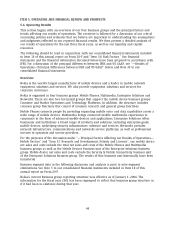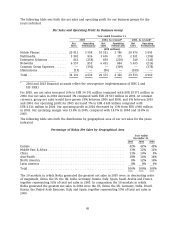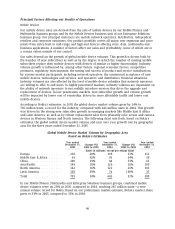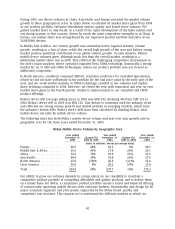Nokia 2005 Annual Report Download - page 40
Download and view the complete annual report
Please find page 40 of the 2005 Nokia annual report below. You can navigate through the pages in the report by either clicking on the pages listed below, or by using the keyword search tool below to find specific information within the annual report.Nokia Research Center
Looking beyond the development of current products, platforms and technologies, Nokia’s
corporate research center develops leading-edge technologies and creates competencies in
technology areas that we believe will be vital to the company’s future success. The Research
Center works closely with Nokia’s four business groups and Technology Platforms to develop new
concepts, technologies and applications.
Our global network of relationships with universities and other industry R&D players expands the
scope of our long-term technology development. For example, in October 2005, Nokia Research
Center and the Massachusetts Institute of Technology Computer Science and Artificial Intelligence
Laboratory announced the establishment of the Nokia Research Center Cambridge.
Competition
Mobile Devices
Mobile phone market participants compete mainly on the basis of the breadth and depth of their
product portfolios, price, operational and manufacturing efficiency, technical performance, product
features, quality, customer support, and brand recognition. Mobile network operators are
increasingly offering mobile phones under their own brand, which may result in increasing
competition from non-branded mobile device manufacturers.
Historically, our principal competitors in mobile devices have been other mobile device companies
such as LG, Motorola, Samsung, Siemens and Sony Ericsson. However, we face new competition,
particularly in Multimedia and Enterprise Solutions, where we compete with consumer electronics
manufacturers and business device and solution providers respectively. We also face new
competitors from countries where production costs tend to be lower. Further, as the industry now
includes increasing numbers of participants that provide specific hardware and software layers
within products and solutions, we will compete at the level of these layers rather than solely at
the level of complete products and solutions. Examples of such layers include operating system
and user interface software, chipsets, and application software such as games software. As a result
of these developments, we face new competitors such as, but not limited to, Apple, Canon, Dell, HP,
Microsoft, Palm, Research in Motion and Sony. We will also face competition from a large number
of smaller competitors and some of our traditional competitors in new areas, as well as
competitors that have chosen to focus on building products based on commercially available
components.
It is difficult to predict how the competitive landscape of the mobile communications industry will
develop in the future. In the mobile communications industry, the parameters of competition are
less firmly established than in mature, low-growth industries, where the competitive landscape
does not change greatly from year to year. See ‘‘Item 3.D Risk Factors—Competition in our industry
is intense. Our failure to maintain or improve our market position and respond successfully to
changes in the competitive landscape may have a material adverse impact on our business and
results of operations.’’
Infrastructure
In the network infrastructure business, our principal competitors include Alcatel, Ericsson, Huawei,
Lucent, Motorola, NEC, Nortel and Siemens. Competition in both the 2G and the 3G network
infrastructure market remains intense. In 2G, competition is driven by price, solutions that are
able to offer low total cost of ownership, and the vendor’s ability to roll-out mobile networks in
high-growth markets. In 3G, vendors compete on the basis of price and track record of network
implementations, as well as in terms of which new technologies they plan to introduce and when.
38



